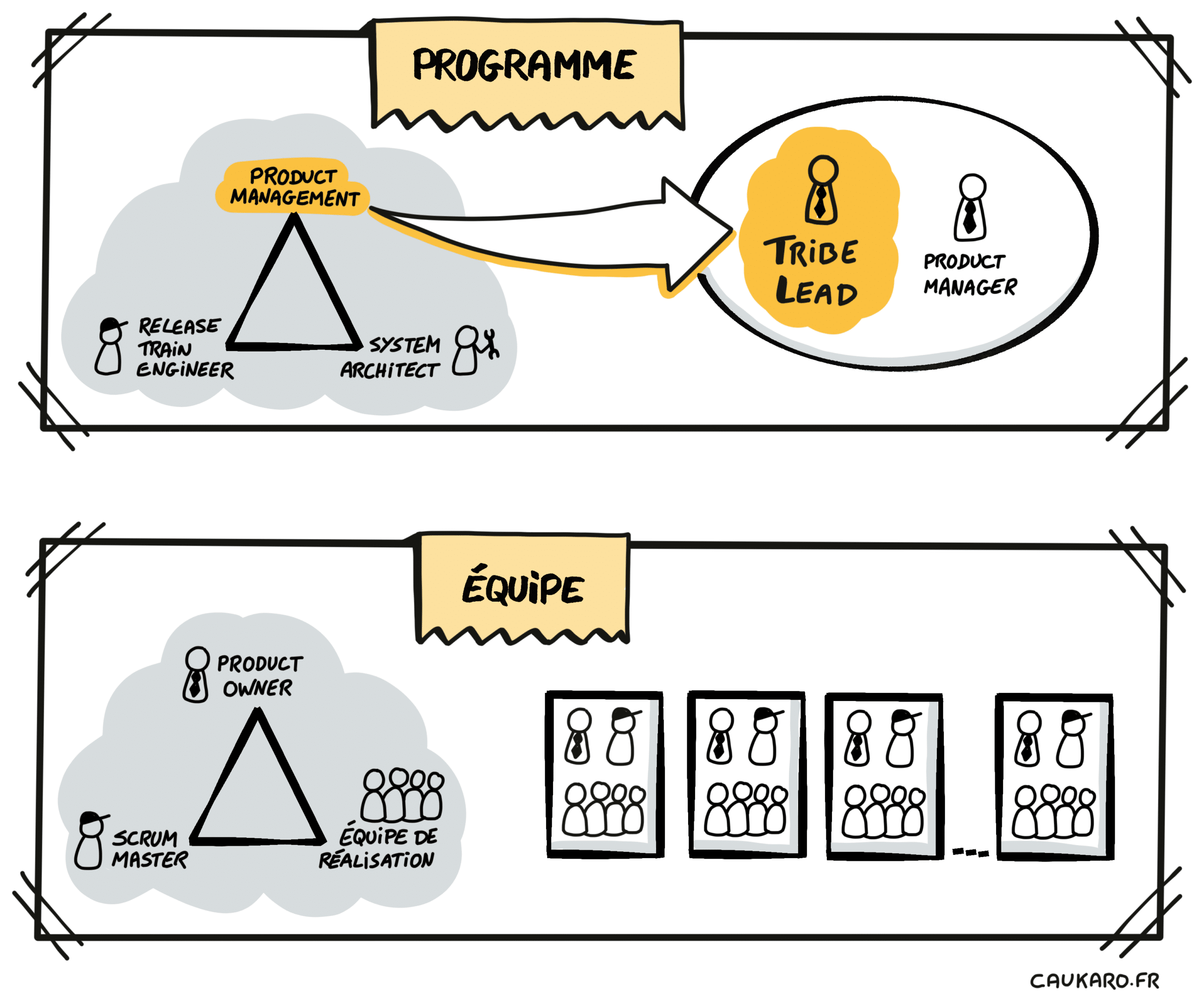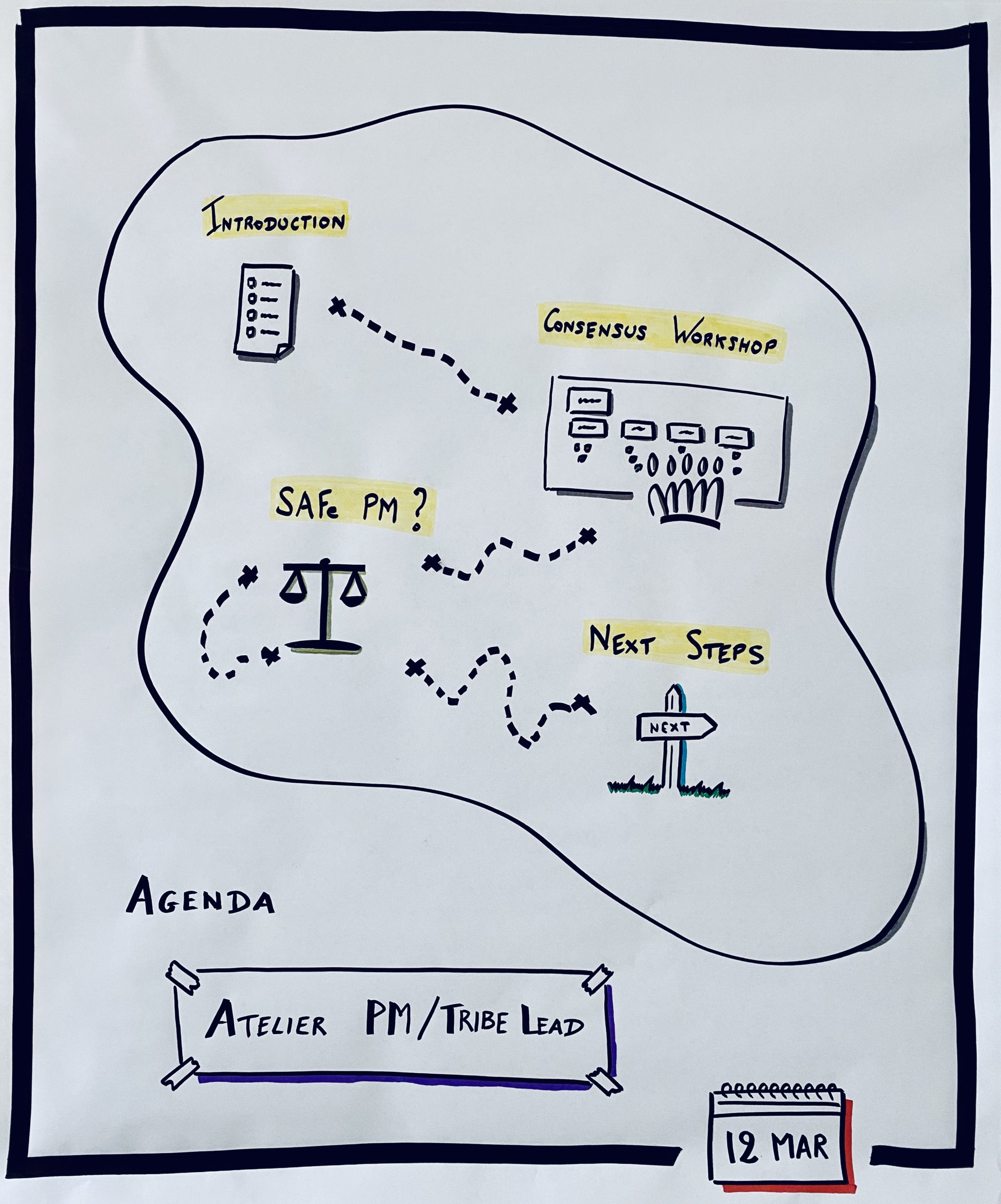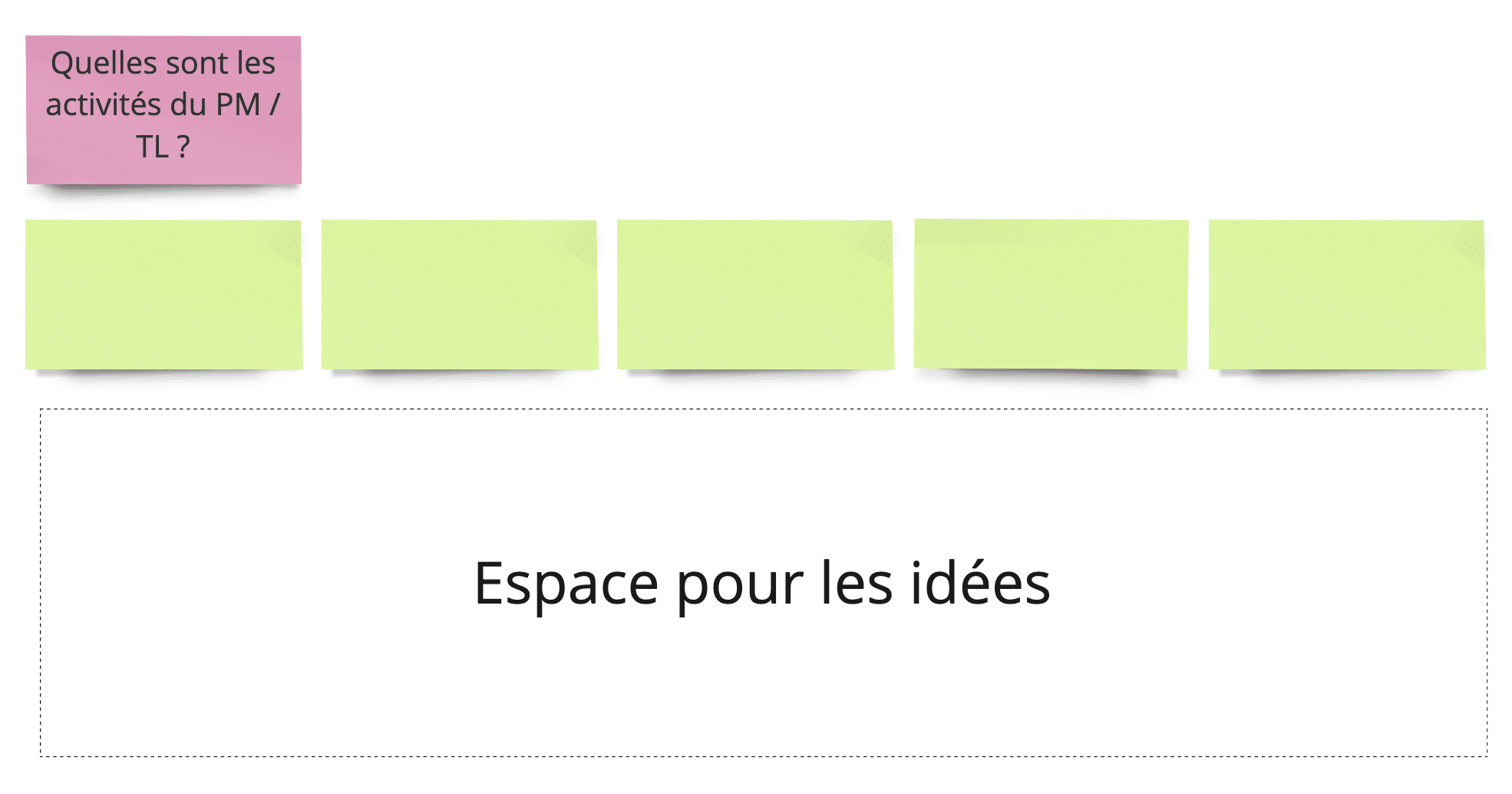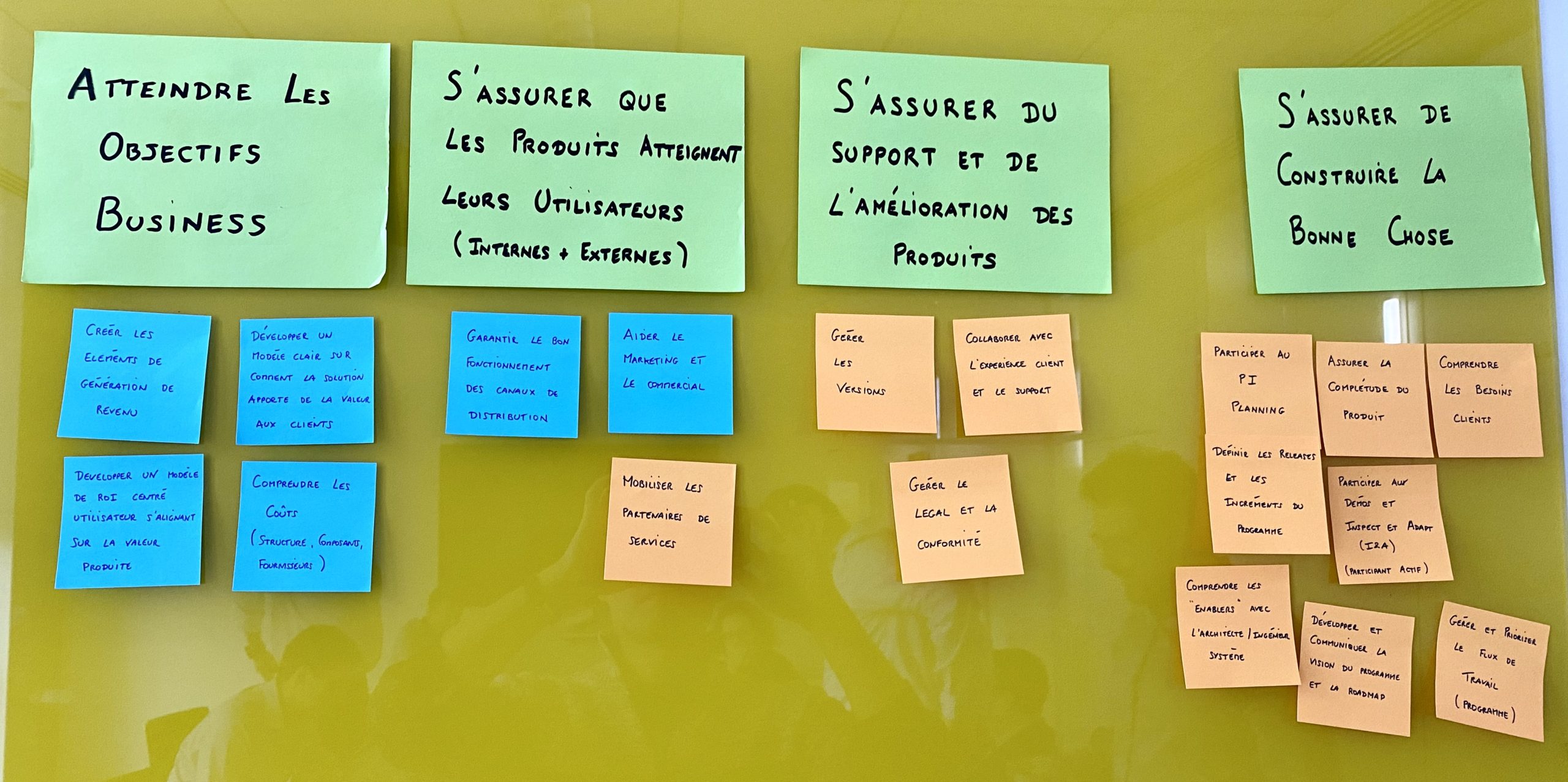Small or large scale Agile transformation, the question of roles is a fairly common problem. Not that she seems normal to me, but often because it's the most reassuring way to change, I feel.
In my case, it was the vagueness established on a particular role that generated some tension and led me to take control of a series of clarification workshops: the opportunity for me to show my client how facilitate this type of "meeting" differently and give a different perspective on transformation.
Here's what happened.
| Note: the workshop took place before the lockdown, so there are still paper Post-its (and that's nice). However, the modus operandi could also work remotely with some adjustments. |
Context

I am currently working in a context of implementing Agility at scale, strongly inspired by SAFe and led by a fairly large group of transformation consultants.
In this framework, we therefore have a layer Crew » and a layer « Program » with in particular a Product Management represented by a committee made up of one person from IT and one person from the business. In a logic that still escapes me, even if the source of inspiration is quite clear, the IT person was called Chief of the Tribe or " TribeLead“. It is this role that has recently posed some problems, thus generating tensions between the different layers of the organization.
It seemed interesting to me to see this pitfall appear now when it had already been three months since presentations of the role had been made by the transformation consultants. It was therefore a good opportunity to have a slightly different approach, based on collective intelligence, rather than on top-down information and sometimes felt as imposed.
It was during a weekly meeting with the key members of management that we decided to organize a clarification workshop around this role, bringing together the people then present in the room. Taking into account the agendas and the urgency of the subject, we agreed at 7 p.m. to hold the workshop the next day at 9:30 a.m.
So I decided to take the hand to be able to:
- Show how to lead workshops / meetings differently
- Show that uninformed application of a framework doesn't make much sense and context is important to consider
Despite these motivating challenges, I nevertheless felt that the night was going to be a bit long or that the alarm clock would ring a bit early! 😛
Design

With the previous elements well in mind:
- I propose a 1h30 workshop telling me that we could finish earlier. Indeed, in a case like this, I prefer to take more time even if it means finishing earlier than to run out of time and everyone stays on their end.
- I consider the number of participants between 4 and 8 people, people planning to come only at the end of the workshop.
We can just start from the list of activities associated with SAFe Product Management and that's it!
Here is what I was told when leaving around 7 p.m. It's an idea indeed, but something tells me that it might not be that simple. I then go to the page dedicated to Product and Solution Management of SAFE to get an idea and for once, I'm not disappointed.
Indeed, the theoretical role includes 4 main responsibilities or missions:
- reach the Business objectives
- Ensure products reach their Users (Internal and External)
- Make sure of Support and of theProduct improvement
- Be sure to build the Good thing
| Note: these elements are the result of my quick translation at a somewhat late hour, sorry! 🙂 |
Each one then breaks down between 3 to 8 activities to specify a little better what is expected.
After a careful reading of the whole, I tell myself that my client is far from all that and that to make it a basis for the workshop would perhaps not make much sense. So I'm going to go in another direction but maybe this research can still be useful! 😉
1.Consensus Workshop
I then opted initially for a Consensus Workshop allowing the participants to confront their perceptions of the role.
Indeed, the interest will be twofold:
- enable them to align themselves with a common vision,
- while taking into account the specificities of their own context.
They will then answer the following question:
What are the activities of the Product Management / Tribe Lead?
| Note: I kept the notion of Product Management because it seemed interesting to me to see how this role in the broad sense was perceived. Although this may blur the question a little, I assumed that each person would answer what he or she understands. |
2. Comparison with SAFe PM
In order to take advantage of my previous research, I will suggest that they compare their vision of the role of Tribe Lead/PM with the theoretical vision of SAFe. This will be a good way for them to see what the common points are, the differences and especially what they want to keep or not.
We will therefore be here in a process of informed decision making, empowering, taking into account the specific constraints of the context and not the mechanics of the theoretical application of a model.
3. Next Steps
In conclusion, we will decide together on the next steps to be implemented in order to be able to activate this result obtained collectively. The opportunity to collect feedback on the course of the workshop at the same time.
Preparation

Like any workshop, preparation is essential. I then set about preparing the different phases, the opportunity to ensure that the mechanics remain fluid and coherent. It all starts with the Agenda 🙂
Consensus Workshop

Preparing for the Consensus Workshop is quite simple:
- Prepare the question to make it visible to all (Pink Post-it)
- Prepare some spaces to structure the categorization work (Green Post-it)
- Prepare the Post-it pads and a marker per person for the data collection phase
| Note: I had the opportunity to find Post-its in A5 format which I find very valuable for this kind of exercise! The fact that there are 5 spaces is totally arbitrary although not exactly - it was the available wall space in width I believe 🙂 |
Comparison with SAFe PM

To make the comparison as efficiently as possible, I decided to use the same color codes as the Consensus Workshop. I then write the PM's missions on A5 Green Post-it notes and the activities on normal square Post-it notes.
Being with a client working mainly in French, I embarked on the translation of missions and activities to avoid problems of understanding in the exchanges (which we do not do for the success of a workshop, right? ? :-P).
| Note: the colors of the square Post-its have no specific meaning. |
So as not to leave them in plain view, I'm going to stick the diary made on a Giant Post-it on them at the start of the session. The idea will be to reveal these elements only in the phase concerned: yes, I wanted to put on a show! 🙂
Animation

So we come to workshop time. Of course, the participants are late and we will not start until around 9:40 am. They will finally only be 4 at first.
After having explained the agenda of the workshop and the different sequences using the visual support, we leave on the Consensus Workshop.
1.Consensus Workshop
After recalling the question, I propose the following mechanism:
- 2 minutes of individual reflection
I find that one minute is generally too short except for people who are used to it, and again. Indeed, there is often a latency at startup which can already take around 15 to 20 seconds to get into the exercise.
- 5 minutes of reflection in pairs, where we remove duplicates
For the first time in this kind of animation, I was asked:
Couldn't we put our answers on the board right away instead?
I caught myself answering somewhat automatically:
No.
Indeed, with hindsight, I think I felt the question as an attempt by the person to stop working: the habit being rather to sit around the table and debate, without structure. I'm not saying that was his intention but that was my perception at the time 🙂
However, I added:
It is important in the process to do this work in pairs in order to filter your results usefully for the rest of the group. I invite you to experience it! 🙂
Everything went well afterwards, the exchanges seeming to be rather engaged.
- Full group sharing
For the full group debriefing, the instructions were rather simple, having to do only 2 pairs: each group exposes its Post-its one by one, if it seems to belong to the same category as another we place under the same Green Post-it A5, otherwise choose another column.
After having unstacked all the Post-its, we work on the naming of the different categories thus constructed. This leads to very interesting exchanges, to changes in the groupings to finally arrive at 5 distinct categories, 1 of which corresponds to questions.
The result obtained was the following:

What we can see is that one of the categories, entitled “Reporting & Representation”, is actually very specific to the client context. Indeed, the activities listed here are mostly from internal operating modes, still current, but which do not appear anywhere in the Agile resources (and this is normal).
This last phase led to a better understanding of the stakes of the role and its constraints for the participants, taking into account the specificities of their own context.
Let us now compare these results to the SAFe theory.
2. SAFe PM Comparison
As expected, I reveal the Post-its hidden under the agenda for this sequence and I hear with pleasure a "Wow" of surprise on the part of the participants. They didn't seem to expect it and the colorful effect of the content may have had its effect! 😛
I present the approach I took to arrive at this result and then present to them what SAFe recommends for the role of PM, theoretically.
After a few exchanges, we agree together that the role of Tribe Lead does not in fact correspond only 1/4 of the role of PM in the SAFe sense. Indeed, the remaining parts to be taken by the trade.
This was a great discovery for the participants but above all a clarification of where they are today: we will thus be able to define together where we want to go next.
3. Next Steps
Following the results obtained in the previous sequences, we then decide on the following steps:
- Organize a similar workshop with the Tribe Leads : to compare their visions with the vision obtained that day
- Organize for each Tribe Lead a individual interview with its Management : to allow him to express his concerns or other aspects that may be more difficult to share in a group
- Potentially organize a interview with a coach : to discuss his position as an Agile leader in an organization as currently set up
Conclusion

Understanding and applying new roles is always a challenge. This is all the more true in an Agility approach on a scale where the latter are often multiplied. Now, it is important to keep in mind that it is not so much the roles that are important but their usefulness in the overall organizational system.
To ensure that everyone can find their place, it seems to me necessary to include them in the solution rather than imposing it on them, especially if it does not take into account the constraints of the context at a given time.
Thus, despite a rather simple animation structure, I think that this workshop was appreciated by the participants. Indeed, I had the opportunity to receive several praises from the "great chef" who arrived at the end of the session on the quality of the animation but also from other participants who were pleasantly surprised by the format.
It's always fun, of course, but I think it's above all a great opportunity to develop practices for more useful and efficient meetings! 🙂
The next article will describe the workshop with the Tribe Leads carried out after the announcement of the lockdown: a somewhat difficult remote facilitation experience!







One Response
Thank you very interesting! I have already used a role definition method called the “expectations matrix”, but this one seems to me to be even more complete and allows me to dig deeper into the details of the missions. Can't wait to see the next article!